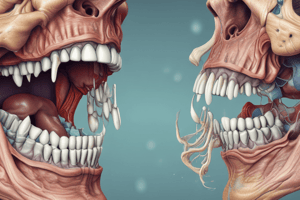Podcast
Questions and Answers
What shape does the maxillary sinus take in adulthood?
What shape does the maxillary sinus take in adulthood?
- Spherical
- Pyramidal (correct)
- Cuboidal
- Narrowed oval
Which artery is primarily responsible for the arterial supply to the maxillary sinus?
Which artery is primarily responsible for the arterial supply to the maxillary sinus?
- Superficial temporal artery
- Facial artery
- Maxillary artery (correct)
- Carotid artery
What type of nerve provides sensation to the maxillary sinus?
What type of nerve provides sensation to the maxillary sinus?
- Infra-orbital nerve (correct)
- Optic nerve
- Trigeminal nerve
- Facial nerve
Which lymph nodes are primarily responsible for draining lymph from the maxillary sinus?
Which lymph nodes are primarily responsible for draining lymph from the maxillary sinus?
What is the primary type of lining in the maxillary sinus?
What is the primary type of lining in the maxillary sinus?
Which of the following veins is involved in the venous drainage of the maxillary sinus?
Which of the following veins is involved in the venous drainage of the maxillary sinus?
When does the development of the maxillary sinus begin?
When does the development of the maxillary sinus begin?
How does infection in the maxillary sinus potentially spread?
How does infection in the maxillary sinus potentially spread?
What is the composition of the mandibular condyle?
What is the composition of the mandibular condyle?
What is the function of the articular disk in the TMJ?
What is the function of the articular disk in the TMJ?
What happens to the trabeculae of the mandibular condyle as a person ages?
What happens to the trabeculae of the mandibular condyle as a person ages?
Which of the following is NOT a characteristic of the articular eminence?
Which of the following is NOT a characteristic of the articular eminence?
What is the term used to describe a dysfunction of the TMJ?
What is the term used to describe a dysfunction of the TMJ?
Which of the following is a symptom of myofacial pain dysfunction syndrome?
Which of the following is a symptom of myofacial pain dysfunction syndrome?
What is the primary cause of myofacial pain dysfunction syndrome?
What is the primary cause of myofacial pain dysfunction syndrome?
Which of the following muscles is NOT involved in mastication?
Which of the following muscles is NOT involved in mastication?
Which type of epithelium lines the maxillary sinus?
Which type of epithelium lines the maxillary sinus?
What are goblet cells responsible for in the maxillary sinus?
What are goblet cells responsible for in the maxillary sinus?
Which of the following cells are most numerous in the epithelium of the maxillary sinus?
Which of the following cells are most numerous in the epithelium of the maxillary sinus?
What is a common symptom of maxillary sinusitis?
What is a common symptom of maxillary sinusitis?
What is opacification in the context of maxillary sinus issues?
What is opacification in the context of maxillary sinus issues?
Which condition may cause proptosis as a complication?
Which condition may cause proptosis as a complication?
What is the primary function of the cilia in the sinus epithelium?
What is the primary function of the cilia in the sinus epithelium?
What structural component makes up the subepithelial connective tissue layer of the maxillary sinus?
What structural component makes up the subepithelial connective tissue layer of the maxillary sinus?
Flashcards are hidden until you start studying
Study Notes
Paranasal Sinuses
- There are 4 pairs of paranasal sinuses: maxillary, frontal, ethmoidal, and sphenoidal.
Maxillary Sinus
- Definition: pneumatic space inside the body of the maxilla.
- Development: first to develop, starts as a tubular structure at birth, becomes ovoid in childhood, and pyramidal in adulthood.
- Arterial supply: branches from the maxillary artery (pterygopalatine part), including posterior superior alveolar artery, infra-orbital artery, and greater palatine artery.
- Venous drainage: anteriorly through the facial vein and posteriorly through the pterygoid venous plexus, which communicates with the cavernous sinus via an emissary vein.
- Nerve supply: anterior superior alveolar nerve, middle superior alveolar nerve, posterior superior alveolar nerve, and infra-orbital nerve.
- Lymph drainage: submandibular lymph nodes, deep cervical lymph nodes, and retropharyngeal lymph nodes.
Microscopic Features
- Lined with a mucous membrane of the respiratory type.
- Epithelium: pseudostratified columnar ciliated epithelium with columnar ciliated cells, basal cells, columnar non-ciliated cells, and goblet cells.
- Cilia: composed of microtubules, providing a mobile apparatus to move debris and microorganisms out of the sinus.
- Goblet cells: mucous synthesizing and secreting cells.
Clinical Significance
- Maxillary sinusitis: inflammation of the maxillary sinus, symptoms include headache, foul-smelling nasal or pharyngeal discharge, fever, and weakness.
- Cancer: carcinoma of the maxillary sinus may invade the palate and cause dental pain, block the nasolacrimal duct, and spread to the brain and lymph nodes.
- Age: with age, the maxillary sinus expands, surrounding the roots of the maxillary posterior teeth and extending into the zygomatic bone.
Temporomandibular Joint (TMJ)
- Formed by the articulation between the articular eminence and the condylar head of the mandible.
- Contains a fibrous intra-articular disk that functions as a shock absorber.
HISTOLOGY
- Bony structures: condyle of the mandible composed of cancellous bone covered by a thin layer of compact bone, with trabeculae radiating from the neck of the mandible.
- Articular disk: composed of dense fibrous tissue, devoid of blood vessels and nerves.
Clinical Considerations
- Myofacial pain dysfunction syndrome: characterized by masticatory muscle tenderness, limited opening of the mandible (< 37 mm), and joint sounds, more common in females.
Studying That Suits You
Use AI to generate personalized quizzes and flashcards to suit your learning preferences.




